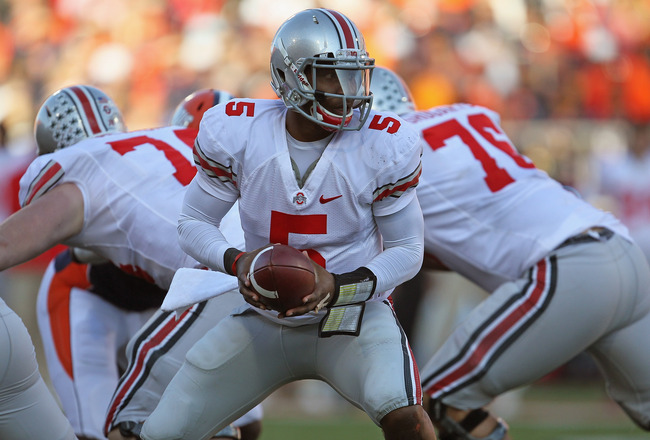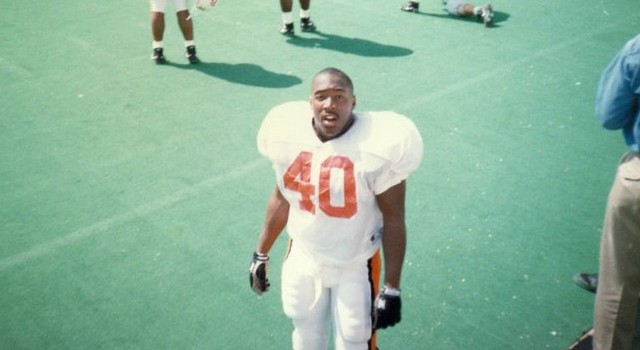COLUMBUS, Ohio — Recent history shows no college football program is immune from an extended slump. The mighty have fallen in unprecedented numbers, and last summer, Ohio State appeared doomed to be the next to serve its sentence in the shadows.
The previously bulletproof Buckeyes stared down the barrel of NCAA investigators, who were dissecting a series of violations committed by players and, the most egregious, a cover-up committed by former coach Jim Tressel. The man some used to call Teflon Tressel had stepped down under pressure. Luke Fickell, a 37-year-old assistant and former Ohio State lineman who had never served as a head coach, received the unenviable task of guiding the team through choppy waters.
The list of college football brand names enduring downturns has swelled: Miami, Notre Dame, Florida State, Florida, Washington, Nebraska, Michigan and, most recently, USC, to name a few. The reasons vary — NCAA violations and penalties, coaching changes, poor coaching hires, poor recruiting, poor performance, greater parity in the sport — but the fundamental theme is that anyone can be brought down. Programs had plummeted because of a lot less than what had transpired at Ohio State.
But the dark clouds above the Woody Hayes Athletic Center didn’t linger. Three days after Ohio State completed a 6-6 regular season, its worst in 12 years, the school introduced Urban Meyer, a two-time national championship winner, as its coach. Although more bad news arrived weeks later, when the NCAA surprised Ohio State’s brass by handing down a one-year postseason ban for the 2012 season, the sting began dwindling when Meyer introduced a recruiting class that ESPN rated as the best in the Big Ten and the sixth-best nationally. The momentum continues as Meyer and his staff have secured verbal commitments from seven recruits ranked in the ESPN 150 for 2013.
Ohio State’s protracted penance has been put on pause, and if Meyer works his magic, the Buckeyes could be back among the nation’s elite in ’13.
“There are very few programs,” Ohio State athletic director Gene Smith told ESPN.com, “that can recover so fast.”
What makes Ohio State’s situation unique? Smith lists the reasons: history and tradition; a huge athletic department flush with resources; a massive alumni base and fan base; top facilities; a location in a state filled with top high school players. He recites a familiar refrain regarding the NCAA violations, calling them “an isolated, individual mistake with individual people,” not indicative of a systematic problem.
A few blemishes couldn’t take the shine off the scarlet and gray.
“We’re still The Ohio State University, a great brand,” Smith said. “It’s not a program that’s been devastated by the challenges we have. When you can attract a good leader like Urban on a platform like The Ohio State University … we weren’t going to spiral.” It begs the question: Is Ohio State football simply too big to fail?
“That’s a good way to say it: We’re kind of too big to fail,” Smith said, “and we’re sometimes successful in spite of ourselves because of the platform. Archie Griffin, John Hicks, Chris Spielman, all those guys rallied to support this program. They’re heavily engaged. [Ohio State has] over 400,000 living alums. A stadium that seats 105,000 every game. Thirty-six sports. It’s a great brand.”
But great brands elsewhere have endured down stretches. If Ohio State can rebound from a situation Smith once called “a nightmare” — with one seven-loss season, its first since 1897, and another without a bowl game — its good fortune will play a significant role.
The Buckeyes needed to make a big-splash hire after the NCAA scandal. Meyer, an Ohio native and a former Ohio State graduate assistant, was floating around the country as an ESPN analyst, unattached to a team after leaving Florida following the 2010 season.
“Everything is about timing,” said Fickell, who Meyer retained as the team’s defensive coordinator. “Who knows why things happen and how they happen at different times, but you probably wouldn’t have been able to script something like this.”
Smith said he never worried about an extended backslide because of two factors: Ohio State’s location in fertile recruiting territory, and the school’s ability to attract an elite coach. What he didn’t know was how the players would respond to the transition.
“We could have had an exodus,” Smith said. “That may have caused us to look at a two-year or three-year rebuilding time. But these kids love it here. So we were able to recover. We’re not a rebuilding program.”
Ohio State had minimal attrition during the coaching transition. The school’s ability to hire a coach like Meyer so quickly helped prevent players from tuning out.
Gene Smith credits Meyer — and the school’s vast resources — with allowing the Buckeyes to survive sanctions relatively unscathed.
“We got one of the best coaches in college football,” tight end Jake Stoneburner said. “He wouldn’t have come here if he thought we were going to [struggle]. His mindset is he’s not going to let us do that. It’s Ohio State. We’ve been great for so long. Why let something bad that happened for a year ruin the next three or four years?
“If you look at this place — the coaches, the players, the recruiting — it’s going to be a long time before Ohio State’s on the downslide.”
That doesn’t mean it couldn’t continue this season, and Meyer inherits some challenges. Ohio State’s offense finished 115th nationally in passing and 107th in total yards last season. Proven playmakers are scarce. The defense returns nine starters and boasts a superstar in lineman John Simon, but the unit didn’t come close to its typical standard in 2011.
This spring, Meyer began installing his no-huddle spread offense, a system on the other end of the spectrum from what Ohio State ran under Tressel. Meyer likened the process to a “clown show” early in the session, but later saw improvement.
“We’re nowhere where we need to be,” Meyer told ESPN.com, “but it’s not as bad as I thought.”
There’s also the question of motivation, which Meyer called a “big concern” entering the summer. The bowl ban erases the typical rewards from Ohio State’s goal board. The Buckeyes’ season will conclude — sadly, mercifully or somewhere in between — on Nov. 24 against archrival Michigan at Ohio Stadium.
Meyer is leaning on the seniors to keep the pedal down. They still have a legacy to cement, and expectations outside the program aren’t about to change.
“It’s difficult to manage because everyone automatically thinks, ‘Oh my God, we’re going to win every game because Urban’s here,'” Smith said. “Our competition’s pretty good, but we aspire to be champions, we aspire to win every game we play. [Meyer] has that same attitude. … The expectation is to have a great season.”
Ohio State can’t win a Big Ten title or a Rose Bowl this fall. But it can prove that 2011 was a stumble, not a fall.
It can prove that maybe one brand-name program is too big to fail.
“That’s up to us,” Simon said. “Our play on the field will decide that. We’re taking every precaution necessary to make sure we don’t fail.”

































Discussion about this post